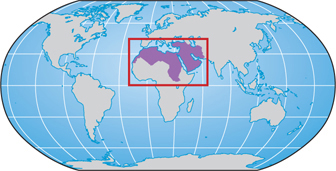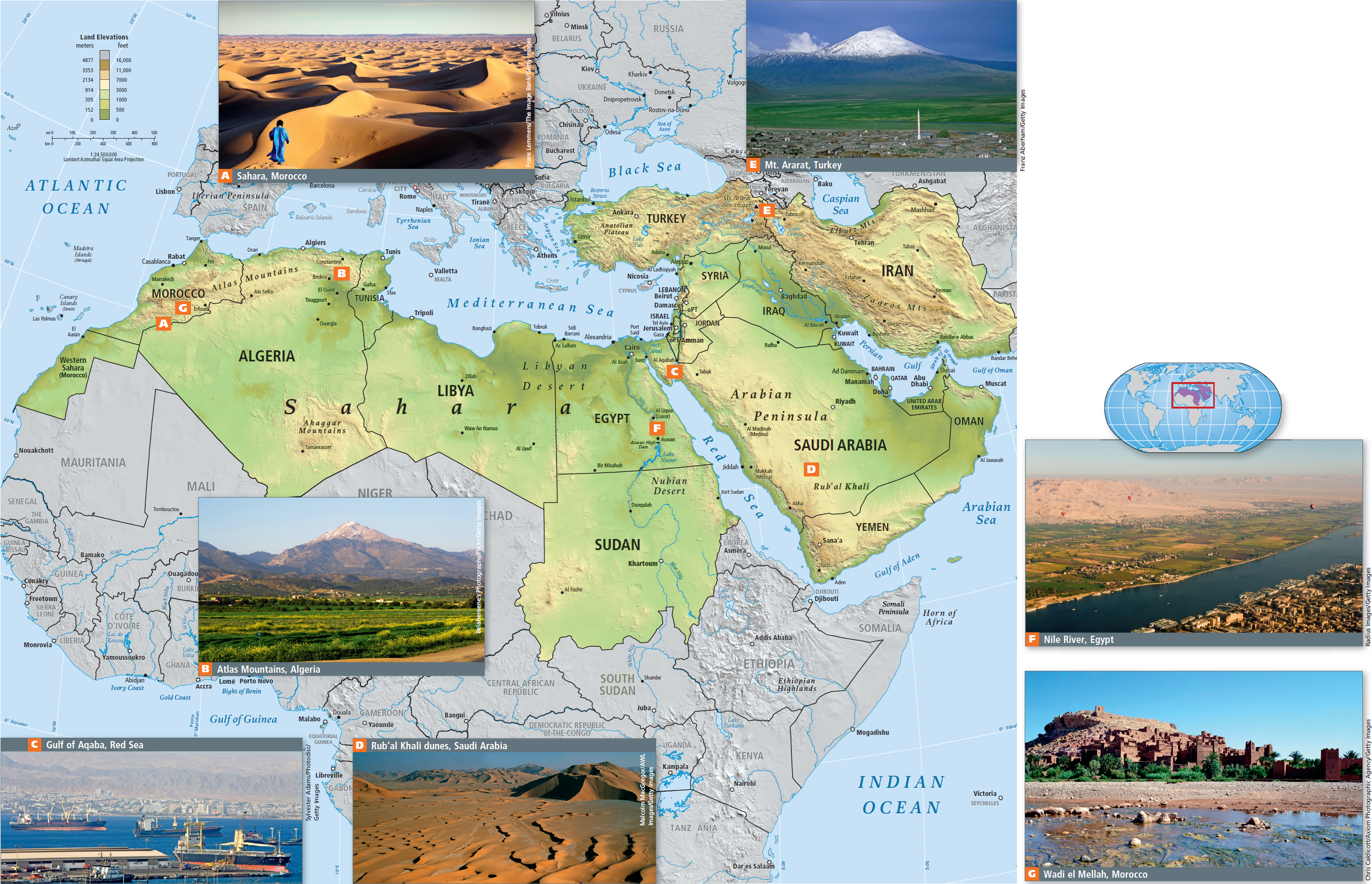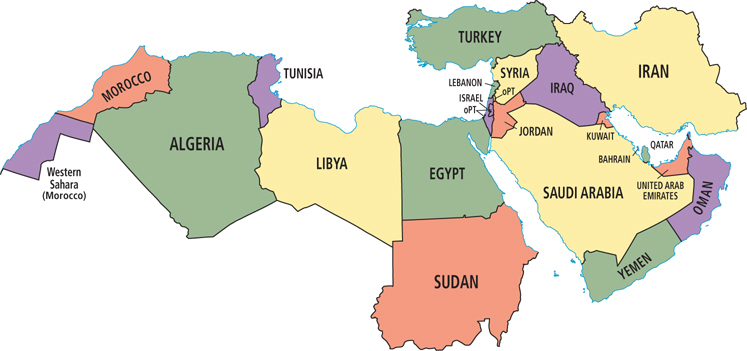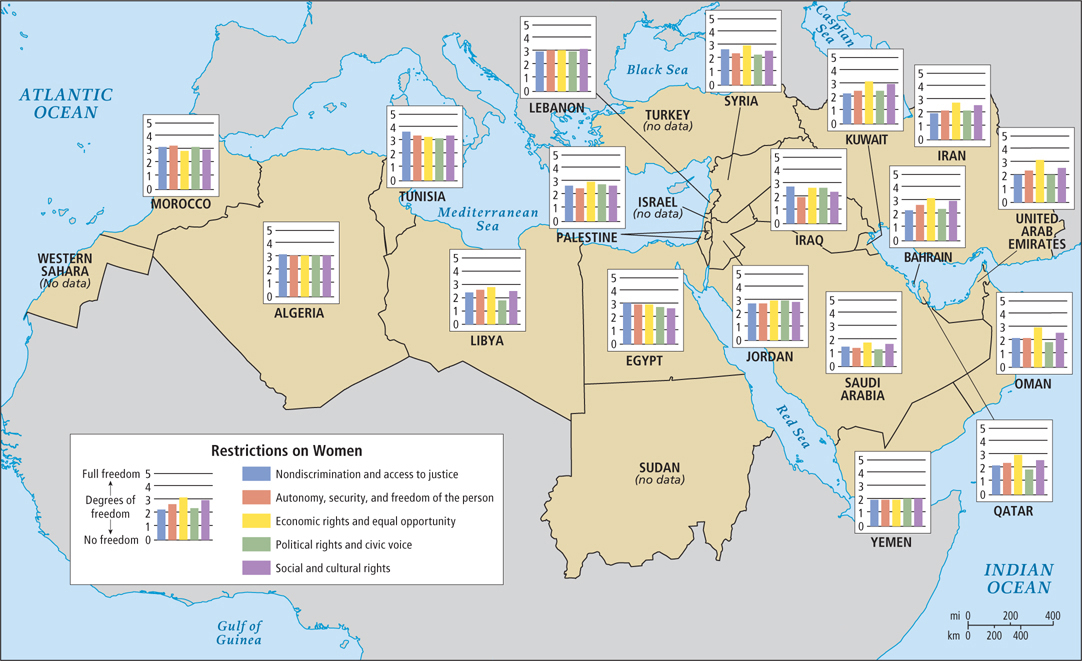6.1 Chapter 6 NORTH AFRICA AND SOUTHWEST ASIA

chapter 6
NORTH AFRICA AND SOUTHWEST ASIA▶
GEOGRAPHIC INSIGHTS
After you read this chapter, you will be able to discuss the following geographic insights as they relate to the five thematic concepts:
|
1. |
Environment: |
The population of this predominantly dry region is growing faster than is access to cultivable land and water for agriculture and other human uses. Many countries here are dependent on imported food, and because global food prices are unstable, the region often has food insecurity. Climate change could reduce food output both locally and globally and make water, already a scarce commodity, a source of conflict. New technologies offer solutions to water scarcity but are expensive and unsustainable. |
|
2. |
Globalization and Development: |
The vast fossil fuel resources of a few countries in this region have transformed economic development and driven globalization. In these countries, economies have become powerfully linked to global flows of money, resources, and people. Politics have also become globalized, with Europe and the United States strongly influencing many governments. |
|
3. |
Power and Politics: |
Despite the presence of elected bodies of government, authoritarian power structures prevail throughout North Africa and Southwest Asia. Beginning with the Arab Spring of 2010, waves of protests swept the region, resulting in the overthrow of several authoritarian governments. Within the region, official responses to the Arab Spring have included both repression and reform. |
|
4. |
Urbanization: |
Two patterns of urbanization have emerged in the region, both tied to the global economy. In the oil- |
|
5. |
Population and Gender: |
This region has the second- |
The North Africa and Southwest Asia Region
The region of North Africa and Southwest Asia (shown in Figure 6.1 and Figure 6.2) contains 21 countries plus the occupied Palestinian Territories. Physically, the region is part of two continents: Africa and Eurasia. The North African countries of this region stretch from Western Sahara and Morocco on the Atlantic Ocean, through Algeria, Tunisia, Libya, and Egypt along the Mediterranean Sea, plus Sudan, which lies south of Egypt. Eurasia begins on the eastern side of the Red Sea with the Arabian Peninsula, which consists of Saudi Arabia, Yemen, Oman, the United Arab Emirates, Qatar, Bahrain, and Kuwait (see Figure 6.1C); the countries of the eastern Mediterranean littoral (shoreline), including Jordan, Israel, the occupied Palestinian Territories, Lebanon, and Syria; and Turkey, Iraq, and Iran. This region is often referred to as the Middle East, a term we do not use in this book because it arose during the colonial era and describes the region from a limited Euro-


The five thematic concepts in this book are explored as they arise in the discussion of regional issues; the interactions between two or more themes are often featured. Vignettes, like the one below about the changing role of women in this region, illustrate one or more of the themes as they are experienced in individual lives.
The Arab Spring, a movement that will likely continue evolving for decades, has been brought on by deep and structural problems. Large numbers of the poor, the uneducated, the educated unemployed, minorities, and women have been pushed further and further into poverty and powerlessness by political and economic systems that have privileged the wealthy and politically connected. Movements like the Arab Spring arise when enough people decide they can no longer tolerate these systems.
The issue of gender equity in the region of North Africa and Southwest Asia is controversial because many people are convinced that only Westerners (meaning people of European origin) raise this issue, and that they do so in order to belittle Muslim culture for having a set of values that places females in a special, and subservient, category. But Mona Eltahawy’s article and the response it has received across the region suggests that gender equity is becoming a central theme in the Arab Spring movement and that women are leading a profound transformation of this region.
What Makes North Africa and Southwest Asia a Region?
To most outsiders, North Africa and Southwest Asia is a region characterized by five qualities: It is the center of the religion of Islam; it holds a great deal of Earth’s petroleum resources; water is generally scarce here; Arab culture dominates most countries; and women are discriminated against more intensely than in most of the rest of the world. While these five features are all present, they alone provide a far too simplistic picture of the region.
The vast majority of people practice Islam, a monotheistic religion that emerged between 601 and 632 c.e. Islam is a faith that is interpreted in many different ways. Most Muslims are moderate in their thinking and accept the validity of other beliefs, especially that of Christianity, because Mary and Jesus both play important roles in Islam. Only a vocal minority of Muslims is drawn to ultra-
Islam a monotheistic religion that emerged in the seventh century c.e. when, according to tradition, the archangel Gabriel revealed the tenets of the religion to the Prophet Muhammad
Islamism a grassroots religious revival in Islam that seeks political power to curb what are seen as dangerous secular influences; also seeks to replace secular governments and civil laws with governments and laws guided by Islamic principles
Fossil fuel reserves—
fossil fuel a source of energy formed from the remains of dead plants and animals
This region is generally arid but the degree of aridity and its impact on development varies widely. Newly revealed underground water resources may change development options.
Arab culture and language is widespread, but many people in the region are not Arab. The population of Turkey and Iran, the second and third most populous countries in the region, are of non-
Finally, the role and status of women, a point of contention for many years, is in transition. The experiences of women vary widely from country to country. In Turkey, women have many more options for education and work than in Saudi Arabia or Yemen. Gender issues also vary between more rural and urban areas. Urban women tend to be more educated, outspoken, and active in commerce, public life, and government, while rural women tend to lead more secluded domestic lives with few educational opportunities. The movement toward greater gender equity is generally strongest in urban areas.
Terms in This Chapter
In this book, as mentioned earlier, we choose to not use the common term Middle East. The term Arab world is used only where it applies, since many people in the region are not of Arab ethnicity.
We use the term occupied Palestinian Territories (oPT) to refer to Gaza and the West Bank, those areas where Israel still exerts control despite treaty agreements; the word “occupied” is lowercase to show the supposed temporary quality of the occupation. The U.S. Department of State uses the term Palestinian Territories. The United Nations, upon recently agreeing to give the territory observer status, now refers to it as the State of Palestine.
occupied Palestinian Territories (oPT) Palestinian lands occupied by Israel since 1967
GLOBAL PATTERNS, LOCAL LIVES
Mona Eltahawy, a Muslim Egyptian-

For the many thousands of women—
Eltahawy, who grew up in Saudi Arabia, the United Kingdom, and Egypt, and who has focused her career on social justice and women’s rights in Egypt, joined the throng of demonstrators. As the protests went on, not only did retaliation by the military and police toward male and female demonstrators become increasingly brutal, but antagonism toward women by the Muslim Brotherhood demonstrators and even from young, more liberal male demonstrators grew, leading to random violence by men against women. Mubarak’s resignation in February 2011 left undetermined the way in which a new government would be established; so as the military asserted control, the demonstrations continued. One day in the fall of 2011, Eltahawy, who continued to report on the increasingly frustrated demonstrators in Tahrir Square, was arrested along with some others. While in custody, both her arms were broken in a beating, and she was sexually assaulted, as were many other women demonstrators.
In her essay, which she wrote some months after her release, Eltahawy raged against repressive political authorities and against Muslim men as a whole, who she expected to be in solidarity with women demonstrators. Her hope that movement toward gender equity would be one of the end products of the Arab Spring was dashed by what she saw and experienced, so she lashed out with a diatribe against the many large and small ways in which she saw women being belittled—

THINGS TO REMEMBER
The Arab Spring, a broad-
based but not centrally organized movement against corruption and toward more political freedom, has spread across the region since 2010. Women are increasingly participating in political movements but continue to face difficulties in doing so.
Issues of gender equity are becoming central to the public dialogue.